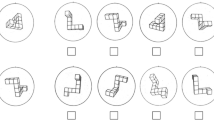Abstract
Subjects, classified as left-or right-movers on the basis of their lateral eye movements, were presented with paired-associates designed to elicit processing by either the left hemisphere (low-imagery synonyms) or the right hemisphere (high-imagery rhymes), followed by both recall and recognition tests. While recall of high-imagery pairs exceeded that of low-imagery pairs, there were no differences in recognition between the two types of paired-associates. There were no differences in retention between left- and right-movers, suggesting that if these groups differ in cognitive style, such differences may not be reflected in measures of information retention. The types of errors the groups made appeared to be influenced more by differences in information processing strategies.
Similar content being viewed by others
References
Bakan, P.: Hypnotizability, laterality of eye movement and functional brain asymmetry.Perceptual and Motor Skills, 25:927–932, 1969.
Bakan, P., and Shortland, R. L.: Lateral eye movement, reading speed and visual attention.Psychonomic Science, 15:93–94, 1969.
Bakan, P., and Strayer, F. F.: On reliability of conjugate lateral eye movements.Perceptual and Motor Skills, 36:429–430, 1973.
Combs, A. L., Hoblick, P. J., Czarnecki, J., and Kamler, P.: Relationship of lateral eye movement to cognitive mode, hemispheric interaction and choice of college major.Perceptual and Motor Skills, 45:983–990, 1977.
Day, M. E.: An eye movement phenomenon relating to attention, thought and anxiety.Perceptual and Motor Skills, 19:443–446, 1964.
Duke, J. D.: Lateral eye movement behavior.Journal of General Psychology, 78:189–195, 1968.
Epstein, W., Rock, I., and Zuckerman, C. B.: Meaning and familiarity in associative learning.Psychological Monographs, 74:4 (No. 491), 1960.
Etaugh, C., and Rose, M.: Lateral eye movement: Elusive personality correlates and moderate stability estimates.Perceptual and Motor Skills, 37:211–217, 1973.
Gross, Y., Franko, R., and Lewin, I.: Effects of voluntary eye movements on hemispheric activity and choice of cognitive mode.Neuropsychologia, 16:653–657, 1978.
Gur, R. E.: Conjugate lateral eye movements as an index of hemispheric activation.Journal of Personality and Social Psychology, 31:751–757, 1975.
Gur, R. E., Gur, R. C., and Harris, L. J.: Cerebral activation as measured by subjects’ lateral eye movements is influenced by experimenter location.Neuropsychologia, 13: 35–44, 1975.
Kimura, D.: The functional asymmetry of the human brain.Scientific American, 228:70–78, 1973.
Klatzky, R. L.:Human Memory: Structures and Processes. San Francisco: W. H. Freeman & Co., 1980.
Kocel, K., Galin, D., Ornstein, R., and Merrin, E.: Lateral eye movement and cognitive mode.Psychonomic Science, 27:223–224, 1972.
McKelvie, S. J., and Demers, E. G.: Individual differences in reported visual imagery and memory performance.British Journal of Psychology, 70:51–57, 1979.
Paivio, A.: Abstractness, imagery, and meaningfulness in paired-associate learning.Journal of Verbal Learning and Verbal Behavior, 4:32–38, 1965.
Paivio, A., Yuille, J. C., and Madigan, S. A.: Concreteness, imagery and meaningfulness values for 925 nouns.Journal of Experimental Psychology Monograph Supplements, 76:1–25, 1968.
Paivio, A., Yuille, J. C., and Smythe, P. C.: Stimulus and response abstractness, imagery and meaningfulness, and reported mediators in paired-associate learning.Canadian Journal of Psychology, 20:362–377, 1966.
Walker, Z. S.: The interactive effects of eye movement patterns with modes of stimulus presentation on the recall of paired-associate learning sequences.Dissertation Abstracts, 34(4-A): 1719–1720, 1973.
Weiten, W., and Etaugh, C.: Lateral eye movement as related to verbal and perceptual-motor skills and values.Perceptual and Motor Skills, 36:423–428, 1973.
Winnick, W. A., and Kressel, K.: Tachistoscopic recognition thresholds, paired-associate learning, and immediate recall as a function of abstractness-concreteness and word frequency.Journal of Experimental Psychology, 70:163–168, 1965.
Author information
Authors and Affiliations
Rights and permissions
About this article
Cite this article
Onken, J.B., Stern, J.A. Lateral eye movements as indicators of processing strategies in paired-associate learning. Pav. J. Biol. Sci. 16, 157–162 (1981). https://doi.org/10.1007/BF03003222
Issue Date:
DOI: https://doi.org/10.1007/BF03003222




